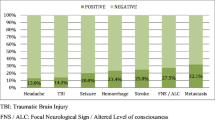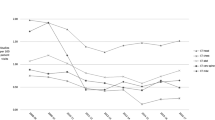Abstract
Purpose
Past studies have identified a high frequency of recommendations for additional imaging (RAI) for computed tomography (CT) studies performed in an emergency department (ED), thereby potentially contributing to increased imaging utilization and costs. The purpose of this study was to compare rates of RAI within the ED setting between ED-based and organ-based subspecialty radiologists.
Methods
We identified 600 ED CT studies, comprising 200 head, chest, and abdominal CT studies, split equally between cases reviewed by ED-based and organ-based radiologists. Frequency of RAI for the three examinations was compared between these subspecialty groups.
Results
Frequencies of RAI were 21.5 %, 13.5 %, and 5.5 % for CT examinations of the chest, abdomen, and brain, respectively. There was a significantly higher frequency of RAI for chest CT studies interpreted by chest radiologists than by ED radiologists (28.0 % vs. 15.0 %, respectively, p = 0.036), largely due to a higher rate of RAI for incidentally detected lung nodules and masses as well as other pulmonary parenchymal abnormalities by chest radiologists. There was no significant difference in RAI on brain or abdominal CT studies between the two groups (p = 0.426–1.0). However, on abdominal studies, only ED-based radiologists provided RAI for abnormalities of the bowel or uterus, while only organ-based radiologists provided RAI for pancreatic abnormalities. Only 25.6 % of RAI were subsequently performed at our institution.
Conclusion
For chest CT studies performed at the authors' institution, differences in management of incidental pulmonary nodules contributed to a significantly higher frequency of RAI by chest radiologists than by ED-based radiologists. Further investigation of the impact of these differences on cost and patient outcomes is warranted.
Similar content being viewed by others
References
Blaivas M, Lyon M (2007) Frequency of radiology self-referral in abdominal computed tomographic scans and the implied cost. Am J Emerg Med 25(4):396–399
Lee SI, Krishnaraj A, Chatterji M, Dreyer KJ, Thrall JH, Hahn PF (2012) When does a radiologist's recommendation for follow-up result in high-cost imaging? Radiology 262(2):544–549
Berland LL, Silverman SG, Gore RM, Mayo-Smith WW, Megibow AJ, Yee J, Brink JA, Baker ME, Federle MP, Foley WD, Francis IR, Herts BR, Israel GM, Krinsky G, Platt JF, Shuman WP, Taylor AJ (2010) Managing incidental findings on abdominal CT: white paper of the ACR incidental findings committee. J Am Coll Radiol 7(10):754–773
Sistrom CL, Dreyer KJ, Dang PP, Weilburg JB, Boland GW, Rosenthal DI, Thrall JH (2009) Recommendations for additional imaging in radiology reports: multifactorial analysis of 5.9 million examinations. Radiology 253(2):453–461
Otero HJ, Ondategui-Parra S, Erturk SM, Ochoa RE, Gonzalez-Beicos A, Ros PR (2008) Imaging utilization in the management of appendicitis and its impact on hospital charges. Emerg Radiol 15(1):23–28. doi:10.1007/s10140-007-0678-x
Otero HJ, Erturk SM, Ochoa R, Ondategui-Parra S, Rybicki FJ, Ros PR (2008) Intestinal obstruction: trends in imaging utilization and their influence in its rising hospital bill. Emerg Radiol 15(5):317–323. doi:10.1007/s10140-008-0726-1
Masciocchi M, Wagner B, Lloyd B (2012) Quality review: Fleischner criteria adherence by radiologists in a large community hospital. J Am Coll Radiol 9(5):336–339
Beigelman-Aubry C, Hill C, Grenier PA (2007) Management of an incidentally discovered pulmonary nodule. Eur Radiol 17(2):449–466. doi:10.1007/s00330-006-0399-7
Furtado CD, Aguirre DA, Sirlin CB, Dang D, Stamato SK, Lee P, Sani F, Brown MA, Levin DL, Casola G (2005) Whole-body CT screening: spectrum of findings and recommendations in 1192 patients. Radiology 237(2):385–394
Barrett TW, Schierling M, Zhou C, Colfax JD, Russ S, Conatser P, Lancaster P, Wrenn K (2009) Prevalence of incidental findings in trauma patients detected by computed tomography imaging. Am J Emerg Med 27(4):428–435
Ekeh AP, Walusimbi M, Brigham E, Woods RJ, McCarthy MC (2010) The prevalence of incidental findings on abdominal computed tomography scans of trauma patients. J Emerg Med 38(4):484–489
Conflict of interest
None.
Author information
Authors and Affiliations
Corresponding author
Rights and permissions
About this article
Cite this article
Rosenkrantz, A.B., Matza, B.W., Foran, M.P. et al. Recommendations for additional imaging on emergency department CT examinations: comparison of emergency- and organ-based subspecialty radiologists. Emerg Radiol 20, 149–153 (2013). https://doi.org/10.1007/s10140-012-1079-3
Received:
Accepted:
Published:
Issue Date:
DOI: https://doi.org/10.1007/s10140-012-1079-3




